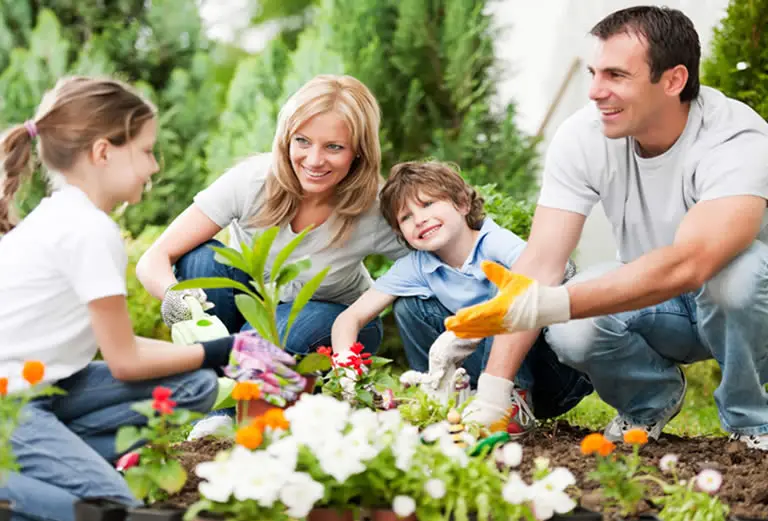Gardening is a great hands-on spring activity that little ones tend to enjoy for a number of reasons. Gardening for kids can be a fun activity; kids are obsessed with soil, mud and all manner of growing things and they don’t care about getting their hands dirty. They just want to keep digging!
Table of Contents
- How to Start a Garden With Your Kids – 16 Top Tips
- 1. Set aside a specific area for your family gardening activities
- 2. Do a little research before you begin – check the soil & know your climate zone
- 3. Pick plants that are easy for your kids to grow
- 4. Plan the layout with the kids
- 5. Consider planting a themed garden to make things more fun
- 6. Use bonsai trees to create a mini garden within the garden
- 7. Get digging – kids love playing in the dirt!
- 8. Let them use kid’s gardening tools
- 9. Talk to your kids about the commitment involved with gardening
- 10. Explain how the kid’s garden can help with family nutrition
- 11. Kid’s gardening ideas for small spaces
- 12. Square foot gardening – allows you to allocate a different area to each child
- 13. Container gardening – works great with mini plants for themed growing
- 14. Cultivating windowsill boxes are a great way to for kids to learn the basics
- 15. Get a head start – you don’t have to wait for growing season
- 16. Have Fun!
How to Start a Garden With Your Kids – 16 Top Tips
Not only does gardening give parents an excellent opportunity to spend some truly quality time with their little ones but the activity itself actually gives kids a chance to develop a sense of responsibility and creativity as they care for their seedlings, and help their plants grow to maturity.
It can also help your child to set and achieve goals which will can develop life-long positive attitudes that help in all areas of their life.
Moreover, if you include vegetable growing as part of your gardening activities your kids can learn how veggies grow and their importance as a source of vitamins and minerals.
This may prompt them to investigate and then grow their very own nutrition-rich vegetables and actually look forward to eating them (which kids usually find intimidating or “yucky”).
Before you start make sure your kids feel like they are really involved in the activity.
There is no point just telling your kids what they should do in the garden. Make sure they are fully involved from the process of planning the planting to the final harvesting.
1. Set aside a specific area for your family gardening activities
It is often a good idea to “fence off” a small piece of your garden and dedicate it specifically to your new family gardening project.
This will become your kids’ special place in the garden. You can make it even more special by creating a theme as outlined below.
2. Do a little research before you begin – check the soil & know your climate zone
Before you start digging make a plan. This starts before your kids are eve involved.
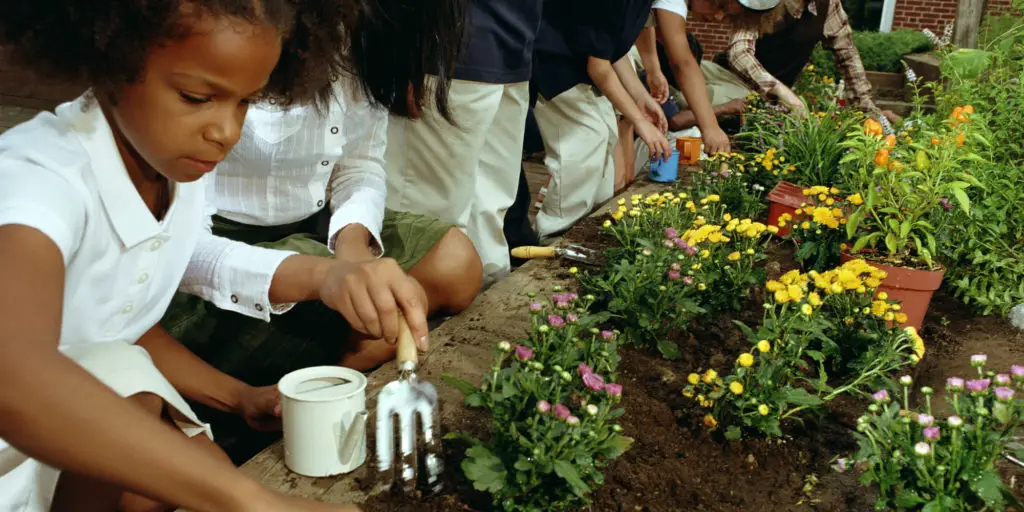
Check your USDA climate zone to be sure you know which plants to pick that will grow the easiest in your location (see our USDA climate zone gardening guide).
Though not completely necessary, if you want to make sure the plants your children sow will definitely grow, also check your soil Ph levels.
3. Pick plants that are easy for your kids to grow
If you plan to plant seedlings or fully grown plants then you are much better buying them from a local garden center or similar store.
Looking at pictures of the grown plants in garden on the internet can hep you and your child pick the ones you want (as long as you know they will grow in your soil and climate).
If you plant to plant from seed, which is usually much more rewarding for kids, then you can easily buy them online. Once you know which types of flowers, plants and vegetables that are best suited to your garden you and your child and browse online for the ones you want. In fact if you buy the seeds online you will get all the information you need about climate and sowing times on the sales page.
This engages the whole family from the very start of the process.
4. Plan the layout with the kids
Be sure that your child can easily get to the garden even in your absence. It’s better to grow plants within the confines of your boundary wall or fence than planting across the yard.
For further convenience, plant near your kitchen window or close to your kitchen’s back door, perhaps in a separate boxed off area, so that you can instantly grab fresh green vegetables for your meal and can tend their plants whenever they wish.
Follow these simple steps when you start gardening with your kid:
Plan before Planting – Keep your climate zone in mind as well as the season and also consider the right plants for your kind of soil. It is easy to check the soil’s Ph value with this handy kit from Amazon and then plan your garden around plants that grow well in such soil.
This will also help you choose the right garden site as you’ll know what plants to grow in your region.
Garden Location – Try to choose a garden site close to water a access point where there’s plenty of sunshine during the day.
The Layout – Consider square foot gardening with several pathways so that your young one(s) can move around without trampling the plants.
The First Plant – Let your child choose what kind of flowers or vegetables they’d like to plant but help them with their choices. This will ensure you not only get the correct plants but will also help you make the process a truly bonding experience.
5. Consider planting a themed garden to make things more fun
Consider setting a theme for your kids’ gardening site or use a multi-theme.
For instance, a salsa or pizza themed garden site means you can grow specific veggies that are staples of those specific tempting meals.
If you enjoy pasta meals why not create an Italian herb garden?
Alternatively you can theme the garden in the style of a movie, cartoon or fairy tale just by adding colorful flowers and plastic toys.
A fairy garden is popular with little girls and little boys alike and you can use a variety of flowers and vegetables, especially mushrooms, to populate the garden area.
Simply sprinkle fairy-like furniture taken from a doll’s house or similar and perhaps place water features such as small fountains and garden similar water features in key areas of the garden beside small doll or fairy house
.
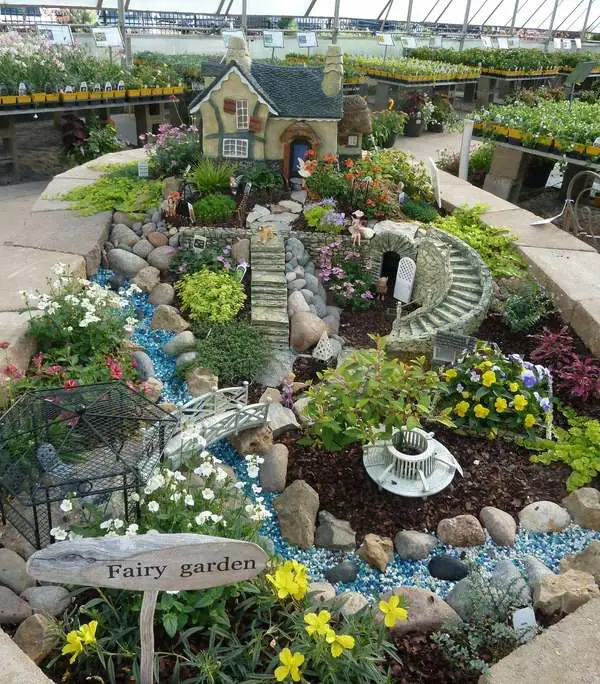
You can even just set up a theme in a large pot and place this in or near your family gardening plot.
There is no end to the ideas you can use for a themed garden.
You can make a spaceport garden, a game of thrones garden or any type of garden you can imagine by simply placing small models in key areas and matching them with appropriate flowers and vegetables. Perhaps plant fragrant small blooms that attract butterflies.
Visit https://www.kidsgardening.org/ for ideas.
A visit to such places. online and offline if you have access, will help kids to learn how veggies grow, how to grow specific flowers to attract beautiful butterflies and bees while you gain a better understanding of how to create a child-friendly gardening environment.
6. Use bonsai trees to create a mini garden within the garden
Bonsai trees are a big hit with kids because they are tiny trees with all the same attributes as their bigger cousins. This makes them perfect for fairy gardens.
If you do plan to plant bonsai trees in your garden I suggest you buy them fully grown from your local garden center as they are difficult to grow from seed.
Be sure to get an outdoor bonsai that is suited to your garden.
7. Get digging – kids love playing in the dirt!
Once you have purchased your chosen seeds or seedlings it’s time to get digging in the soil.
This will probably be one of the most fun bits for the kids. Digging will instantly excite them as children naturally love mud and dirt and are always ready to explore the unknown.
Consider getting your kids there very own gardening tools which will make them feel truly a part of the activity.
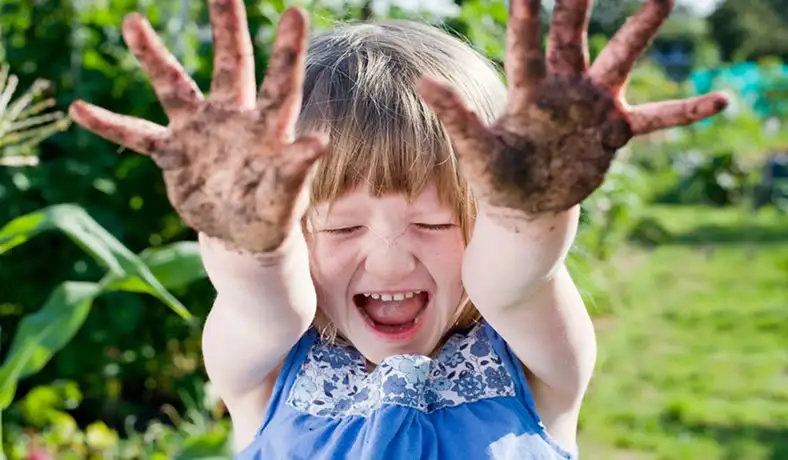
Once they understand how to break up the soil properly for seeding.
Let them choose which plants they want to grow together i.e. let them chose the spot for growing each plant – unless the specific plants would compete aggressively for resources and cause growth and/or plant health issues (most plants can grow together perfectly fine).
If you have completed your initial research correctly (which should take no more than 30 – 60 minutes at most) then all your plants should be fine growing together.
Continue with the process of planting or seeding and help them learn how to pack the soil compactly making sure it is not too compact or too lose. Then allow the kids to water the seeds/seedlings.
The process of starting the garden, especially from seed, will help your kids to understand the importance of patience. Seeing seeds sprout into plants can be a magical and memorable part of their childhood as they will feel responsible for creating life.
The fact that they have achieved this with you will make the entire activity a life-event that they will fondly recall for the rest of their lives.
8. Let them use kid’s gardening tools
For parents, it’s important to look at the garden from their child’s perspective.
Usually, children are unaware of the vegetables growing underground like tubers and they might ruin them without you knowing it.
They may also decide to explore with garden tools that pose a safety risk such as spades, shears, hoes and other sharp cultivators.
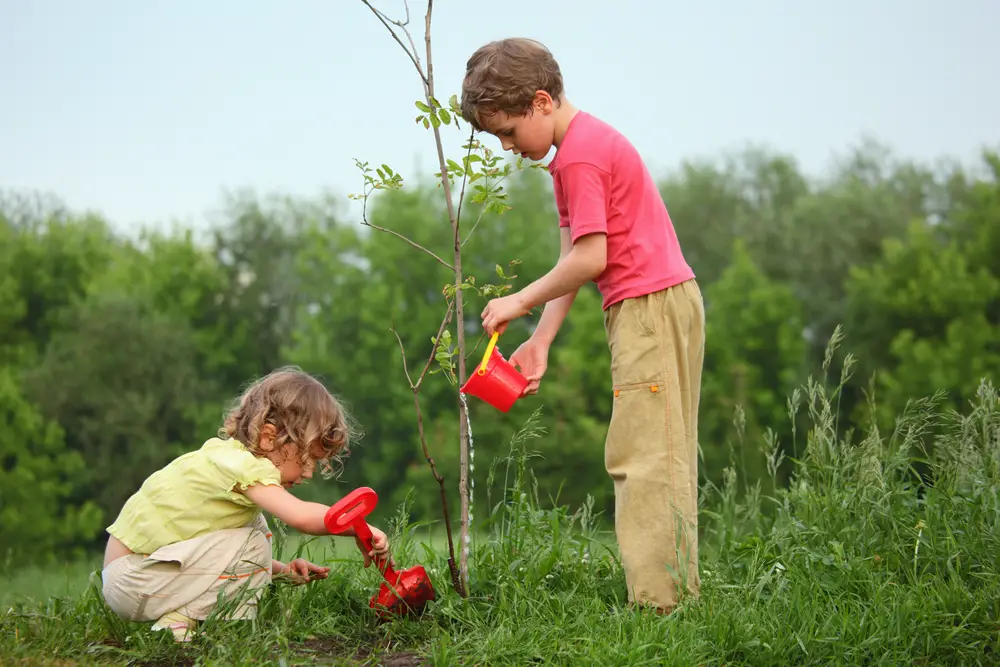
Children normally don’t give it a second thought before reaching for these tools because they saw mommy or daddy using them.
Therefore, it’s important to keep adult tools away from the reach of children.
As an alternative, buy them their own small-sized child-specific garden tools. Children love to have their own colourful and personalized garden tools.
Some plants are physically similar to flowers but they’re poisonous to the touch. Pesticides can also put your child’s safety at risk.
Make sure you’re looking for all such red flags before letting your child explore the garden.
Of course to be on the safe side you can use child & animal friendly pesticides available from Amazon. This is something I highly recommend everyone uses so they avoid harming bees and other living organisms essential to the local and global ecosystem.
In case you find yourself having to use pesticides, do not forget to rinse the vegetables thoroughly before using them.
As an alternative, you can also introduce natural predators to your garden in order to keep it pesticide-free.
9. Talk to your kids about the commitment involved with gardening
Talking to your children about the changes you want to make to your garden and the overall design you are all working towards. This is a great way to help them develop persistence for more important things later in life.
Gardening can be a bit time consuming and you don’t want that time wasted.
Tilling soil, planting seeds and then looking after the plants as they grow, in order to maintain their health, requires regular effort and some know-how (which you may now be lacking).
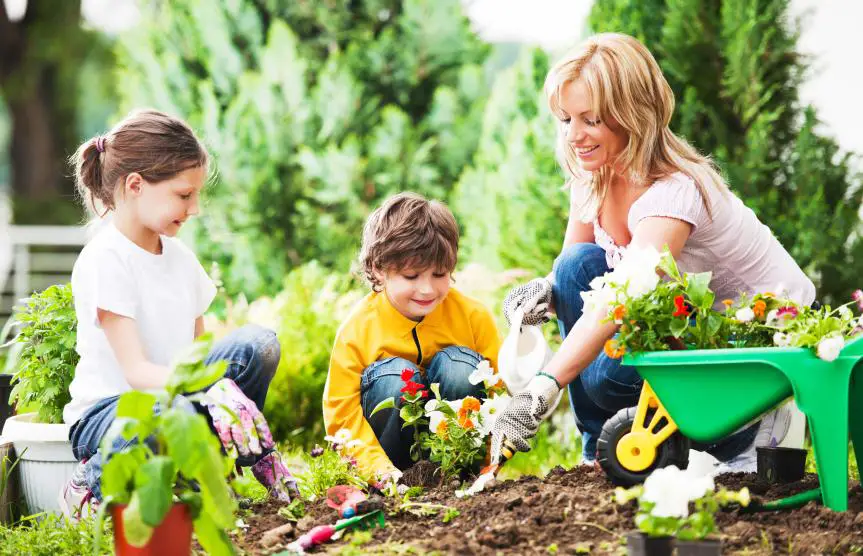
However, starting a garden, even just a small patch in your existing space, can be very easy and such a rewarding activity that your child, and you, will remember and treasure the experience for the rest of your life.
Obviously for this reason it is important that you try your best to make the garden successful.
You need to ensure you acquire at least a little fundamental knowledge about the type of plants that are best suited to your type of soil and your area’s climate.
Obviously you want to avoid the disappointment your child will experience if their plants die.
So, as the adult it is your job to do the research, although you can also make this a family activity.
To get started, do a little research with your kids about the type of plants you would both like, being sure to pick either local plants or ones that suit your environment and climate.
This is especially important if you live in a dry climate.
Make sure you get seeds that need that are best sowed in the months you plan to be gardening. You should also consider getting seeds that are best sowed a month or two apart so you are continually adding new plants to your family garden.
10. Explain how the kid’s garden can help with family nutrition
When you put a plate full of fresh leafy vegetables in front of your kid, how does he/she react? Generally, they will be less than pleased or tell you that he/she is no longer hungry. Simply put, most kids are picky eaters.
However, there’s a great way to get your children to eat nutritious, organic vegetables through some simple fun activities. That miraculous solution is of course gardening!
While gardening with your children, you can ask them to pick a vegetable they would like to see grow and encourage them to grow vegetables that they do not normally like to eat.
Once they have grown the vegetables themselves you will find that it is almost impossible to stop them from eating the fruit of their labors.
Somme great veggies to help develop a love for vegetables in your child, and that are easy to grow, include:
- Lettuce – It grows quickly, giving your child very fast results. Growing lettuce is also a great way to build their interest in salads and its easy to grow nature will help build their confidence in their gardening skills.
- Radishes – It’s a reliable crop and will also give your child quick results as it usually germinate in 3 to 10 days. Radishes have a really short growing season though; almost 20 to 30 days.
- Cherry Tomatoes – Your child can have all the fun with growing these. Their bright red appearance is always a winner with little ones.
- Pumpkin – If you have enough space, pumpkins are a must have when gardening with your children and they come in handy at the end of October when the witching season hits. Seeds are most likely to sprout within a week and vine leaves will start to form quickly after that.
For quick results, plant a variety of quick growing vegetables and make sure they are planted where they gets plenty of sun.
Use seedlings rather than planting from the seed directly for even faster results though your kids will have a much greater sense of achievement when they successfully grow from seed.
11. Kid’s gardening ideas for small spaces
A small space is no reason to keep your child away from all the gardening fun and its essence. In fact as we seen above some themed garden plots would work better in small spaces such as fairy gardens.
Consider the following ideas for gardening on a small and manageable scale:
12. Square foot gardening – allows you to allocate a different area to each child
The idea of square foot gardening involves planting a variety of plants in a small space using raised beds.
Simply construct a raised bed and fill it with soil, plant seeds and water.
Enjoy as your organic vegetables grow steadily.
You can make each raised bed a different theme.
13. Container gardening – works great with mini plants for themed growing
This is just another version of a raised garden.
The idea revolves around growing vegetables in small containers or vine crates.
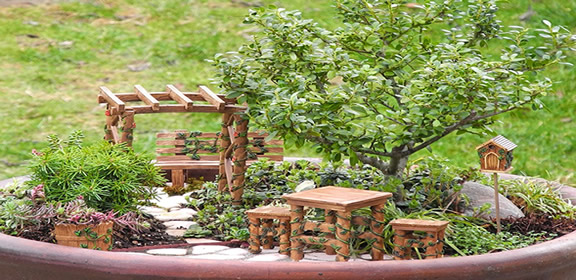
Being portable, they’re highly convenient and you can move them around when needed.
Like the raised beds you can make each pot a different theme and even give each child his own pot to look after.
14. Cultivating windowsill boxes are a great way to for kids to learn the basics
If the above two ideas don’t fit your garden space then this one might.
Consider growing veggies and flowers that are well suited to window boxes. For example, lettuce grows great in on windows simply by sowing it in an attachable bucket or window container.
Imagine how convenient it will be for your kids when they harvest these leafy greens right from your window.
15. Get a head start – you don’t have to wait for growing season
You don’t have to wait until spring to start your family garden project.
You can begin the sowing process indoors and use some creative ways to make the activity even more fun.
For example you can use empty milk cartons, decorated or colourful clay pots or creative raised planter boxes for indoor growing.
These types of growing containers can grab your kid’s attention and spark their imagination right from the beginning.
This is a great way to get your kids started out-of-season. You can begin seeding your plants indoors a few weeks or months prior to the growing season and allow them to grow over the winter ready to replant in the summer.
You could also start preparing your chosen garden area with the new theme your family has chosen. This can easily been completed out-of-season so that all the preparation work is done before you start planting.
Then you can just launch into the actual gardening when the sowing season begins.
16. Have Fun!
Regardless of how you decide to proceed with your garden be sure to make the entire process fun. Don’t take it all too seriously.
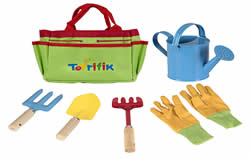 Try to incorporate fun items into your gardening activities.
Try to incorporate fun items into your gardening activities.
There are tons of great fun things you can add to your gardening activities from planting colorful pinwheels to including garden gnomes.
Make sure to give your kids their own gardening tools designed specially for children. This way they can dig up the garden safely and feel that they are really part of the activity while having their very own garden equipment.
You will find that the reward of growing a garden with your child goes way beyond enjoying a peaceful, fragrant setting or having your own tasty organic veggies.
You will build a stronger relationship with your children, help them to gain some great skills from the obvious gardening abilities that they will develop to being able to set and achieve goals.
However, by far the most important aspect of gardening with your kids is that you are actively building strong positive memories for both you and your kids that will last a lifetime.

